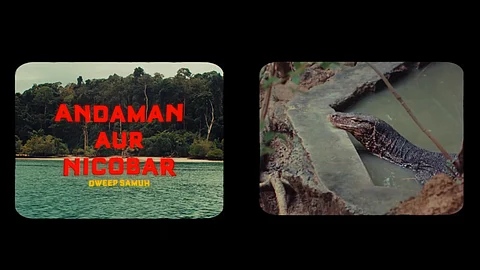
- HOMEGROWN WORLD
- #HGCREATORS
- #HGEXPLORE
- #HGVOICES
- #HGSHOP
- CAREERS
- ABOUT US
- CONTACT US

Aditya Yashvardhan’s, a.k.a. Yash's, short film is a deeply personal piece — a journey back to his birthplace, Andaman and Nicobar Islands, revisiting it for the first time since he left as a child. “My unusual itinerary consisted of the places where my Mum and Dad went on dates, or the roads where I’d be tucked between them on a 100cc Suzuki Samurai for our weekends at the beach,” he recalls. Each stop on this map brims with anecdotes, from childhood misadventures to moments of quiet family joy. “The day could start with a bounce in my heels and may end with panic because there’s a coiled king cobra in the backyard,” he says.
The film, he explains, is an attempt to encapsulate the absurd beauty of growing up surrounded by nature and raised by “a couple of fun-loving oddballs.” Through this lens, Aditya crafts a narrative that is as much about memory as it is about rediscovery.
Turning the camera on his life came with its own set of challenges. “This is the first time that I was shooting something out of my own life,” he admits. The experience taught him the importance of maintaining objectivity. “Being so close to the subject blinds you to things that have context personally, but for the uninitiated, it becomes less accessible. If it’s meant to be shown to the world, however personal, it needs to be made with the same level of critical analysis that you’d otherwise have for your work.” He underscores the delicate balance between personal storytelling and universal relatability — a tightrope every filmmaker walks when drawing from intimate experiences.
Aditya’s artistic influences are as varied as they are timeless. “The music and cinema of Bollywood from the 60s to the early 2000s is definitely burned into my brain,” he says. He also finds inspiration in the works of classical painters like Jean-Léon Gérôme and Eugène Delacroix. In film, he credits directors ranging from Satyajit Ray and Wong Kar Wai to Wes Anderson and Hrishikesh Mukherjee. His sources of inspiration, too, are surprisingly eclectic. “Music from all around, fashion of the past, cabals and scandals from yesteryear, and larger-than-life personalities throughout history are definitely my biggest sources of inspiration,” he says.
Relying on everyday triggers, Aditya’s creative process is fluid and intuitive. “I usually look for triggers all the time. Either from photos, music, or maybe a dialogue between people,” he explains. Avoiding complete works of art as references helps him develop ideas in a unique way. Once his ideas take shape, he begins writing, allowing the visuals to form in his mind before moving to execution. “I plan and shoot while improvising on the go. It keeps evolving as more creatives get involved with their own signature,” he says, highlighting the collaborative nature of his work.
Through his evocative storytelling, and deeply personal approach, Aditya invites us into his world — one that is both uniquely his and universally resonant. Art, at its best, bridges the deeply personal with the profoundly relatable.Nishant Gita's Photoseries Is A Celebration Of Classical Dance Tradition & Expression
Follow Yash here.
If you enjoyed reading this, here's more from Homegrown:
Nishant Gita's Photoseries Is A Celebration Of Classical Dance Tradition & Expression
Imdad Barbhuyan's New Photoseries Is An Exploration Of Grief, Fragility, And Resilience
Faith and Death: Rikrivu Banerjee's Photoseries Explores The Duality Of Life In Banaras
